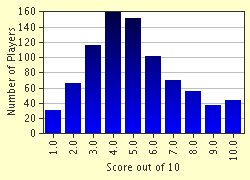Quiz Answer Key and Fun Facts
1. According to the Pythagorean Theorem, the square of the hypotenuse of a right triangle is equal to what?
2. The Pythagorean Theorem only applies to right-angled triangles. However, there is a more general "law" that governs all triangles in a relationship similar to that of the Pythagorean Theorem. What is the name of this law?
3. Moving on several hundred years, in Italy in the 1500s there arose a great dispute between two leading mathematicians named Cardano and Tartaglia over a new method. What was this method?
4. Moving on to the great Swiss mathematician Euler, he was one of the first to really explore infinite series. It has been known for a long time that the harmonic series (1+1/2+1/3+1/4+...) diverges, but that the infinite sum of the reciprocals of the squares (1+1/4+1/9+1/16+1/25...) converges. Euler was the first to determine the exact value of convergence, what is it?
5. Fermat's Last Theorem is undoubtedly the most famous theorem in all of mathematics, first being proposed in the 1600s but not fully solved until the mid 1990s. What method was used to finally solve this centuries-old problem?
6. Another famous theorem was first conjectured in the 1800s, but was not solved until 1976 in a highly controversial way: the proof depends on the use of a computer. To which theorem am I referring?
7. An example of a deceptively simple-stated theorem with an extraordinarily difficult proof is the Jordan curve theorem. What is the fundamental result of this theorem?
8. Ernst Kummer tried in vain to prove Fermat's Last Theorem, and his method (similar to Fermat's own) broke down because not all rings have the "nice" property of unique factorization. Studying these unique factorization domains did not lead to a proof of Fermat's Last Theorem, but it did lead to the study of these:
9. Cantor made waves in the traditional mathematical community by proving what?
10. Finally, a practical application. There is a result that says the following: if you climb up a mountain in a certain amount of time, and then climb down the mountain the next day in the exact same amount of time, there is at least one location on the mountain that you were at both days at exactly the same time (from when you started). Note that you can change your speed, stop to rest, take different paths, etc; you will always have one fixed point in your journey. What result guarantees this?
Source: Author
Mrs_Seizmagraff
This quiz was reviewed by FunTrivia editor
crisw before going online.
Any errors found in FunTrivia content are routinely corrected through our feedback system.


